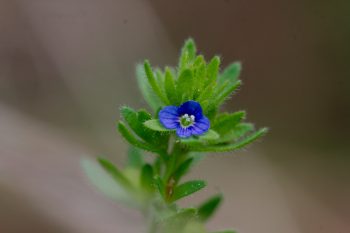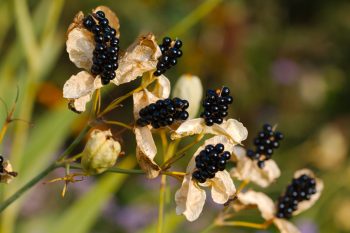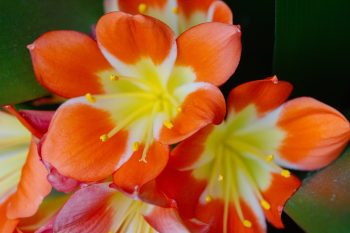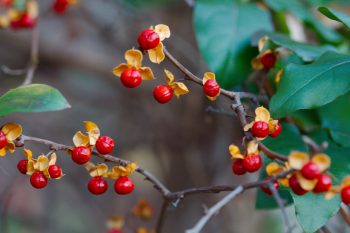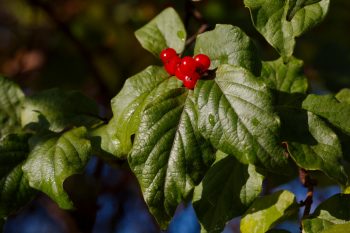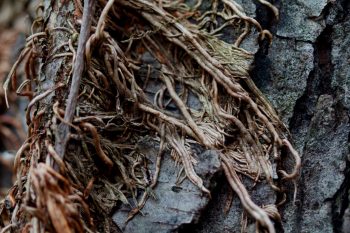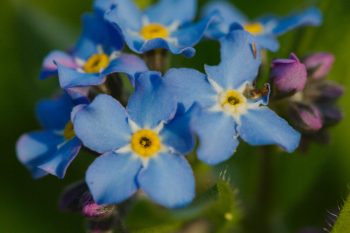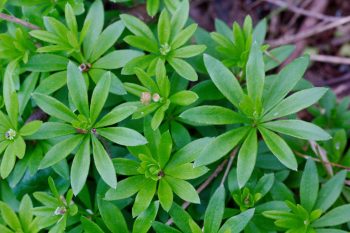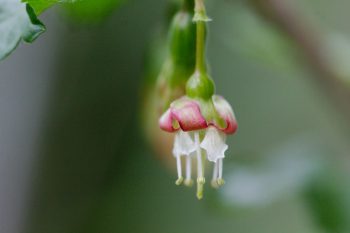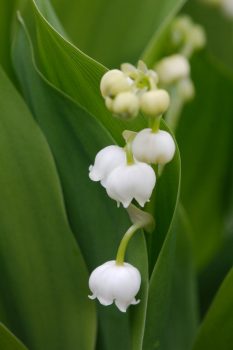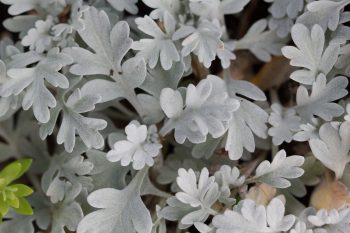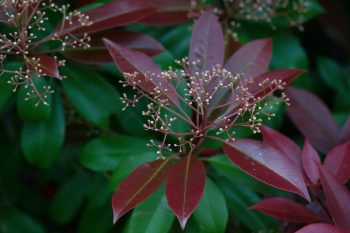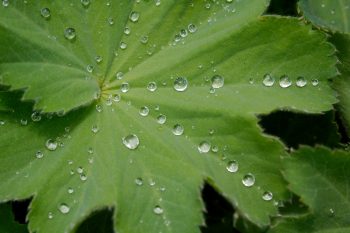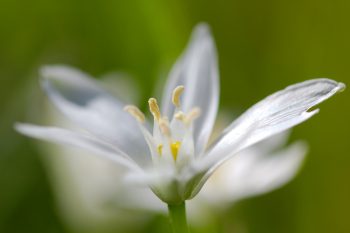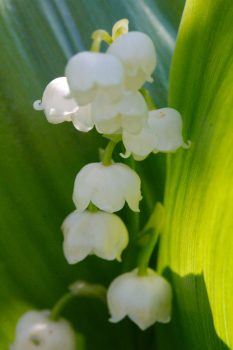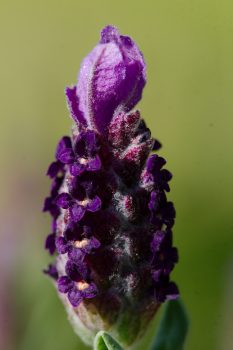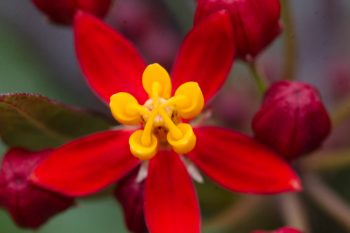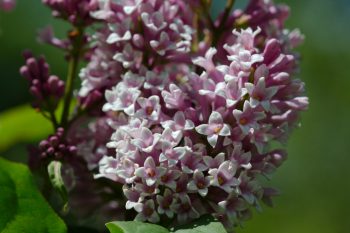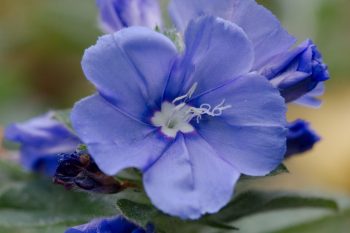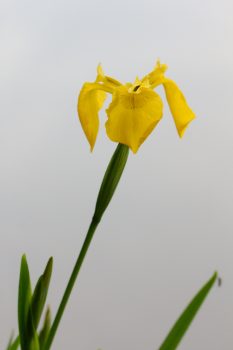It was a beautiful day and I took the opportunity to go out and take a few pictures in the empty lot next to my office. Although we had a lot of rain this winter and early in the spring, April has been relatively drier than usual (at least that’s how if feels, I haven’t checked the actual data). Nevertheless, the drainage pond that is usually dry in the summer was about has high as it can be without the entire upper area being a bog. In a slightly higher part of the area I found quite a bit of this little corn speedwell (Veronica arvensis) growing. It’s a native to Europe and has been introduced widely in North America (according to the US Department of Agriculture, it can be found in every state except North Dakota, and I wouldn’t be surprised if it’s actually there, too. The blooms are quite small, only about a quarter inch across, and are a lovely blue color. As weeds go, there are worse.
Tagged With: Non-Native Plant
Veronica arvensis (Corn Speedwell)
Blackberry Lily (Iris domestica)
The flowers on this plant, Iris domestica, the blackberry lily, don’t really give much clue to their common name. When they go to fruit, however, it’s a little clearer where that comes from. They do have a certain blackberry-like look to them. The flowers are a bright orange and are really lovely. The leaves are very iris-like and are beautiful, sculptural fans of varying shades of green. In fact, I’d be tempted to grow these even if they leaves were all they provided. But the flowers are welcome and I like the fruit, as well. We scatter these fairly liberally around the garden and they are now coming up in various places. They aren’t so aggressive that we worry about them taking over, either, which is nice.
Clivia miniata (Natal Lily)
I have had this Clivia for quite a few years now, since a coworker left it to me when she stopped working here. I had it at home for a while but two years ago I brought it to my office and it’s been doing pretty well. It gets literally no direct sun light with my north-facing window but it seems to be doing well with that. They don’t tolerate frost and are grown as houseplants here but they must be wonderful in a garden in their native South Africa and Swaziland. The blooms, as you can see, are quite bright and vary a bit from the orange seen here to yellow and nearly red. Thank you, Emily, for this long-lasting gift.
Oriental Bittersweet (Celastrus orbiculatus)
Cathy and I went for a walk near Lake Frank today, parking on Bauer Drive and walking in through a break in the houses (there’s a lot that’s not privately owned) and then along the road that leads, within the park, the the parking area. That road and parking area are not in use and haven’t been for many years although I’m not entirely sure why. It was a pleasant walk and we enjoyed the late autumn colors reflected in the lake as well as the oriental bittersweet (Celastrus orbiculatus) in a few places. I don’t recommend growing this, but I have to admit it’s pretty.
Lonicera maackii (Amur Honeysuckle)
This is one of the more prevalent weed shrubs in our area. The Amur honeysuckle (Lonicera maackii) is an east Asian native that has firmly established itself as noxious weed in the eastern half of North America. It’s got the sweet, tubular flowers typical to honeysuckles, starting out white and aging to yellow. They are followed in the fall (right about now, obviously) by bright red, juicy berries. Although they are inedible to humans, birds eat them and spread the seeds far and wide. They were once planted as an ornamental and you can see why. However, they are no longer recommended, because of their invasive nature.
Ivy Roots
There are places where English ivy (Hedera helix) looks really nice. It’s also a very good ground cover for many situations. Nevertheless, I’m not a huge fan. In a city, where it can perhaps be contained reasonably well by paving, etc., it’s suitable. In the suburbs and rural areas it can really be an annoyance. This ivy is growing up a tree near my office and you can see how it grips its host. It will grow up into the tallest trees and eventually strangle them. It also covers the ground so completely that in often chokes out less aggressive plants (and there are only a few more aggressive). We’ve done our best to eliminate it from our yard and with a small patch that seems to reappear occasionally, we’ve succeeded. But we remain on DEFCON 3 or higher.
Myosotis sylvatica (Woodland Forget-me-not)
The woodland forget-me-not (Myosotis sylvatica) is blooming in our back yard. Cathy planted these and they have spread to various places, mostly in the lawn, and they are very pretty little things. Similar to the flowers of the Virginia bluebell (Mertensia virginica) he buds are pinkish purple and the flowers change to blue as they open and mature. Also, the little white “eye ring” around the center change from white to yellow. They are delicate little flowers and although they are not a native species, they are lovely and don’t go to crazy in our yard, so I don’t mind.
Galium odoratum (Sweet Woodruff)
This will start blooming in a week or so, but even before it’s in bloom, sweet woodruff (Galium odoratum, also known as sweetscented bedstraw) is quit pretty. In fact, I’d say this photo doesn’t do it justice. The shades of green are just lovely and it makes a really nice groundcover where you don’t need something evergreen. We have a few patches of this and I really like it where it is. It isn’t too aggressive and it fits in very nicely. When crushed, it gives off a strong odor of freshly mown hay, even more so as the plant dries.
Gooseberry Flower
The plant this gooseberry flower is on was one that Albert had growing in his yard. Brady left me dig it up before she moved out of that house and it’s done very well against our back fence. Dorothy made little tarts with gooseberries from it last year and it looks to have a pretty good crop again this year, if the number of flowers tells us anything. The flowers are generally considered insignificant, at least from an ornamental standpoint. They are quite small and not particularly showy except from very close but they are actually pretty little things. The gooseberry (Ribes uva-crispa) is native to Europe, N. Africa, and the Caucasus and is, as you’d guess, primarily grown for it’s wonderfully tart fruit. The leaves of gooseberries contain hydrogen cyanide, a toxin that, in sufficient quantities, is pretty bad for you.
Lily of the Valley (Convallaria majalis)
The lily of the valley (Convallaria majalis) is starting to bloom. We have it in a few places around the yard and these are at the front corner of our house where they get just a bit more sun than the other places so are a little ahead. It’s a lovely plant and has lovely, sweetly fragrant flowers but all parts of the plant are very poisonous so if that makes you nervous, you might want to avoid it. It contains cardiac glycosides, “a class of organic compounds that increase the output force of the heart and increase its rate of contractions.”
We dug some up in a yard that was being torn up when a road was being widened and it was growing through asphalt paving, so it’s pretty tenacious. We have it in a fairly large bed in the back yard but it is actually being forced outward by Vinca minor which I wouldn’t have thought possible.
Dusty Miller
Dusty Miller (Jacobaea maritima, a.k.a. Senecio cineraria) is a marginally hardy, herbaceous perennial. It’s hardy here, anyway. We have it growing in an urn-shaped container near the end of our driveway and it seems happy enough. It does have flowers but they are not particularly ornamental and many people prune them off so as not to distract from the foliage, which is what the plant is generally grown for. It does well in both shade and sun and really takes very little care.
Photinia × fraseri
Cathy and I took a walk in the neighborhood this evening. That’s been something we’ve done a lot more of since we can’t really go out as we once did. Spending time outdoors is important for mental health, I think, and particularly in the spring when the weather is so nice, it’s a real blessing to be able to get out. These are the leaves and flower buds of a Photinia × fraseri shrub around the corner from our house. As you can see, the new leaves are red and it’s quite a striking plant, particularly when growing in full sun, where the color can be even more stunning. Photinia × fraseri is a hybrid of P. glabra (Japanese photinia) and P. serrulata (Taiwanese photinia).
Alchemilla mollis ‘Auslese’
It’s a week early for Mother’s Day but we’ve been cooped up for too long and we didn’t want to wait until next week. We took our annual trip to Fehr’s Nursery early this afternoon and Cathy bought a load of plants. As usual, I wandered around and took photos of flowers, etc. I got some nice pictures of various hens and chicks (Sempervivum varieties) including some Sempervivum arachnoideum, which have what look like cobwebs on them. I decided to go with this photo, however, of lady’s mantle leaf (Alchemilla mollis ‘Auslese’) with water droplets on it.
Ornithogalum umbellatum (Star of Bethlehem)
The Star of Bethlehem (Ornithogalum umbellatum) is a pretty, little, but invasive bulbous plant native to Europe, northern Africa, and the Middle East. It’s coming up in our back yard and we really should do something about it, although it’s hard to want to pull out something as pretty as this. I’m not sure where it came from as we only have it growing in our lawn and not in any of our garden beds. This time of year they just appear in the lawn. Our mower is out of commission until I get a new carburetor so the grass is getting long but once that’s running again, these will be mowed along with the grass.
Lily of the Valley (Convallaria majalis)
I know I’ve already had a picture this spring of the lily of the valley (Convallaria majalis) from our garden but it’s blooming so well and so long that I thought I’d share another. We’re also in a little lull where there isn’t a lot new coming out, although it’s still changing. So, here’s another view of the little white bells of the lily of the valley, this time from the back garden, near the fence (not that it makes much difference, of course). Soon the flowers will be gone and even the leaves will fade in the coming heat of summer. We are near the southern limit of where it grows well. If you grow it here, it needs some shade to protect it from the heat of the summer sun but further north it does well in full sun.
We also have a terrific crop of Canadian thistle (Cirsium arvense) coming up among it (and many other places, as well) and it really needs to be dealt with. That’s a really problematical weed, having “a deep and wide-spreading root system with a slender taproot and far-creeping lateral roots.” (Source: Fire Effects Information System, US Forest Service). That same document also says that “new plants can also form from root fragments as short as 0.2 inch (6 mm),” which helps explain why it’s so hard to get rid of.
Lavandula stoechas ‘Anouk Supreme’
Last year, after getting rid of the stump from the Colorado spruce that I cut down, we planted a hawthorn to one side of the bed and Cathy planted some perennials as well. Two of them are a variety of Spanish lavender (Lavandula stoechas) called ‘Anouk Supreme’. They are blooming now and they are quite lovely.
Each individual inflorescence is nice, as you can see here, and overall the entire plant is really nice, with lots of blooms. The individual flowers are a very deep purple and the bracts at the top are only slightly less intense. Both the leaves and the flowers give off that wonderful lavender aroma that we’re all so familiar with.
We haven’t done terribly well with plants like this in the past but I think this is a good location for them. If they do well, I’d be happy to get a couple more. We also have a rosemary that we might put here with them. This species of lavender is native to the Mediterranean countries including France, Spain, Portugal, Italy and Greece.
Asclepias curassavica ‘Silky Red’
One of the plants Cathy bought on our annual Mother’s Day trip to the nursery (a week early this year) was this blood flower, Asclepias curassavica ‘Silky Red’. As you can see, the colors are pretty intense. This species of butterfly weed is native to the Caribbean and Central and South America and is only winter hardy to USDA zones 9 to 11, so we grow it as an annual here but it’s worth it. The butterflies and other insects love it and even without that, it’s just a beautiful flower. If you have a very bright indoor location (or a heated greenhouse!) then you could bring it in for the winter, but we just start new each year.
Lilacs
Many years ago my dad gave me a subscription to a thing called The Seed Guild. The idea was that this guy had relationships with botanical gardens and arboreta around the world and had worked out an arrangement where he collected seeds from them and distributed them to Seed Guild members. I don’t remember the details but I do know the seeds for this lilac came from there. The catalogs I have (from the late 1990s) list three species, Syringa amurensis, S. josikaea, and S. wolfii, so I assume it’s one of those three. I’m leaning towards the last of them, which may more properly be known now as Syringa villosa subsp. wolfii (C.K.Schneid.). I had it growing in a container for many years and it never got very big. When we moved here in 2006 I planted it in the back garden and now it’s about 8 feet tall and obviously doing well.
Evolvulus ‘Blue My Mind’
This is yet another tender perennial grown here as an annual. It’s a non-vining, morning glory-like plant native to Brazil. It’s a member of the convolvulus family (a.k.a. the bindweed or morning glory family, Convolvulaceae) but it doesn’t twine and the genus, Evolvulus, means to untwist or unravel. This variety, ‘Blue My Mind’, has beautiful, pale, sky-blue flowers about an inch across. This does really well in hanging baskets or other containers and that’s where this is destined to go, but so far it’s among the plants waiting to be potted up.
Iris pseudacorus, (Yellow Flag)
I took pictures in the yard earlier today but then Cathy and I went to Meadowside Nature Center and took a walk there. Since most of my pictures this spring have been from the yard, I decided to feature a photo from off-site today. We walked from the nature center down to the creek (North Branch Rock Creek) and from there to the lake. We could see the eagle’s nest and at one point saw one of the juvenile eagles sitting on the edge of it. We stopped and sat by the edge of Lake Frank and I took some photos of these yellow flags (Iris pseudacorus), growing on the shore. They are native to Europe and western Siberia, the Caucasus, and northern Africa. They’re quite lovely and I particularly liked the way these were shown against the grey of the very still water. We enjoyed watching the swifts or swallows skimming around over the lake. We heard a barred owl a few times in the distance.

